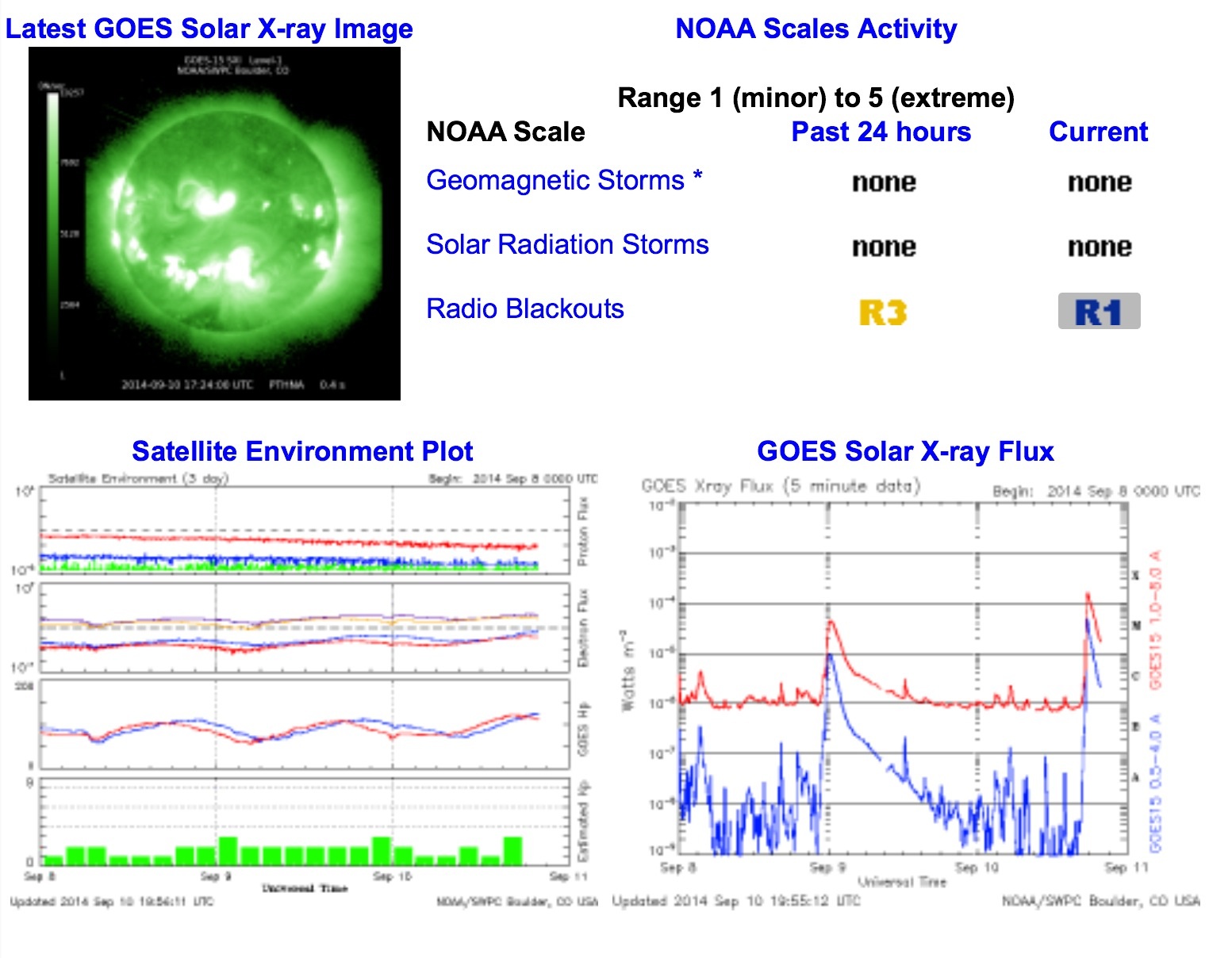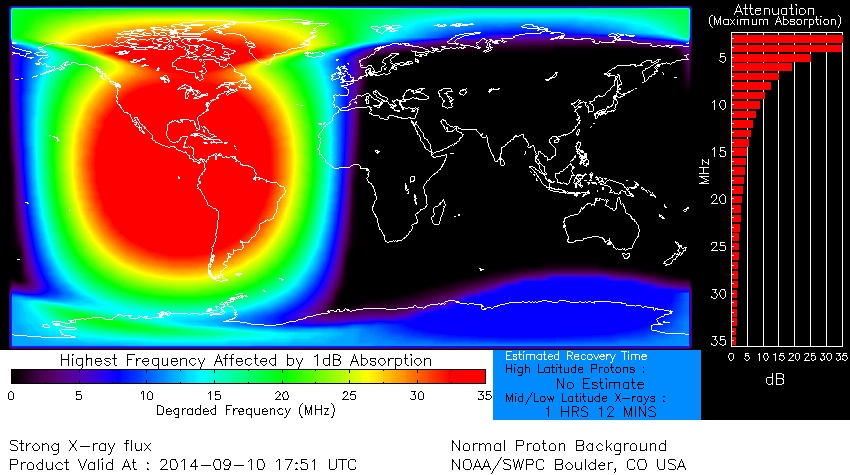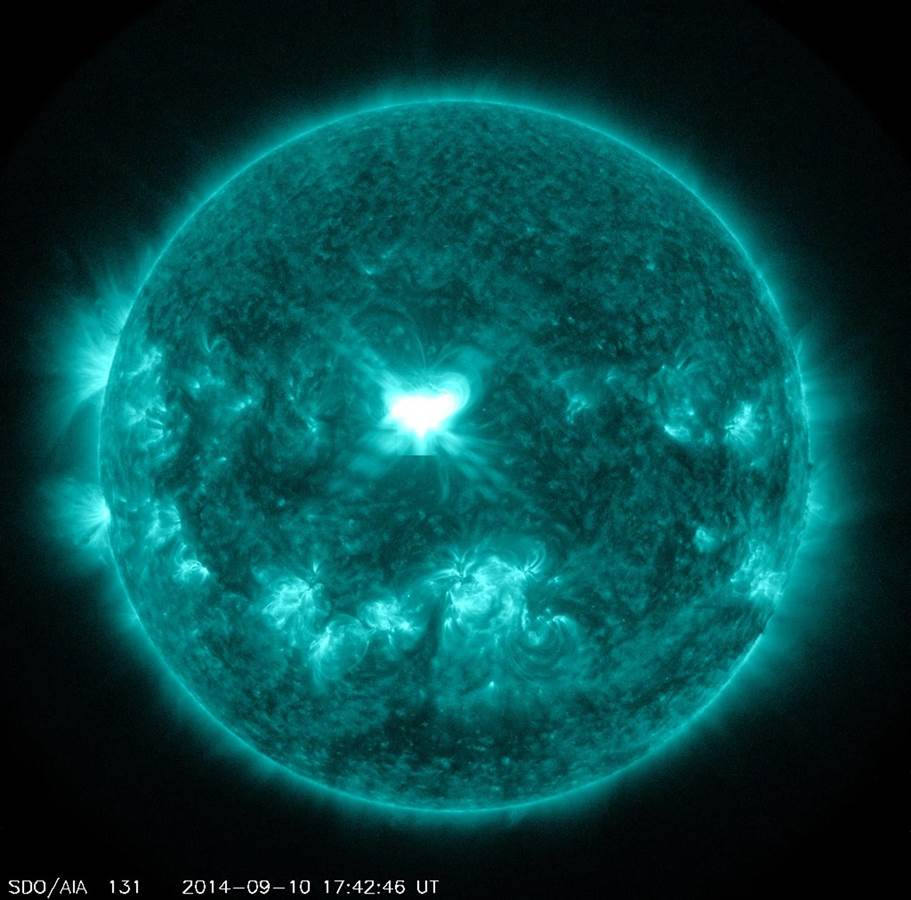It looks like you're using an Ad Blocker.
Please white-list or disable AboveTopSecret.com in your ad-blocking tool.
Thank you.
Some features of ATS will be disabled while you continue to use an ad-blocker.
share:
Powerful X Class Flare
Soaceweather
X-FLARE: Earth-orbiting satellites have just detected a powerful X1.6-class solar flare (Sept. 10 @ 17:46 UT). The source was active sunspot AR2158, which is directly facing Earth. NASA's Solar Dynamics Observatory recorded the extreme ultraviolet flash:
Soaceweather
edit on 10-9-2014 by violet because: (no reason given)
Solar Storm Warning: Sun Shoots X-Flare Outburst at Earth BY ALAN BOYLE A cantankerous sunspot region erupted with a powerful X1.6-class solar flare at just the wrong time Wednesday. The blast was pointing right at us. That means any resulting outburst of electrically charged particles, known as a coronal mass ejection or CME, could have a disruptive effect.
"Initial information suggests that CME is likely associated with this event, but further analysis is underway at this time," the National Weather Service's Space Weather Prediction Center reported on its Facebook page.
Solar storms don't have a significant impact on human health, although high-altitude fliers and astronauts may get an extra dose of radiation. In a worst-case scenario, the storms can deal a blow to orbiting satellites and power grids on Earth. In a best-case scenario, they merely cause heightened auroral displays.
It generally takes a couple of days for the charged particles associated with a CME to make their way to Earth. The sunspot region is known as AR2158, and it's been acting up over the past few days. Wednesday's flare was detected at about 1:45 p.m. ET and was strong enough to cause a wide-area blackout of high-frequency radio communication for about an hour. X-class flares represent the most powerful kind of solar blasts (as opposed to medium M-class flares or the lower-energy A, B or C classes). Solar scientists spotted a triple-X outburst in June, but none of those blasts was directed toward Earth. Check SpaceWeather.com for more on the solar storm, and if there are significant developments, we'll update this item. First published September 10th 2014, 12:09 pm
NBC news
Wednesday's flare was detected at about 1:45 p.m. ET and was strong enough to cause a wide-area blackout of high-frequency radio communication for about an hour.
edit on 10-9-2014 by violet because: (no reason given)
Newa reply to: violet
New to ATS and have limited knowledge with regard to solar flames other than can cause power cuts etc. Is this big enough to cause major problems to us and how long till it hits earth. Sorry for questions but bit clueless about such thinks although quite knowledgable about others.
New to ATS and have limited knowledge with regard to solar flames other than can cause power cuts etc. Is this big enough to cause major problems to us and how long till it hits earth. Sorry for questions but bit clueless about such thinks although quite knowledgable about others.
Forgive my stupidity but solar flares cause the aurora borealis ? I'm going to be high in the Scottish mountains as of Monday next week. Do solar
flares especially large ones have a few day life spans ? What would be the chances of me getting a glimpse of the northern lights banking on clear
weather in Scotland
a reply to: anxiouswens
I think they take 2 pr 3 days to hit earth
And can effect the power grid and radio or GPS

I think they take 2 pr 3 days to hit earth
And can effect the power grid and radio or GPS

edit on 10-9-2014 by violet because: (no reason given)
edit on 10-9-2014 by violet because: (no
reason given)
Will the ISS reposition itself in order to avoid the radiation? Somewhere in the back of mind if my memory serves me correctly, they repositioned not
that long ago in order to avoid a possible collision with a falling satellite. Someone clarify for me please?
edit on 10-9-2014 by aboutface
because: (no reason given)
Gee, I don't go on the net for fifteen hours and then forget to look at space weather before logging on and something happens. We have clouds and
rain here today. I did scan all the new science daily articles and read three, but didn't do my daily look at space weather. I feel I messed up
again.
Good catch. They haven't figured out if there was much of a cme yet, I suppose that news will soon appear.
Good catch. They haven't figured out if there was much of a cme yet, I suppose that news will soon appear.
a reply to: anxiouswens
www.spaceweather.com has a great explanation. Sounds like auroras could be visible this weekend in northern US states like Maine and Michigan or similar latitudes. Unless you are on the space station or flying at high altitude over the poles shouldn't impact you.
www.spaceweather.com has a great explanation. Sounds like auroras could be visible this weekend in northern US states like Maine and Michigan or similar latitudes. Unless you are on the space station or flying at high altitude over the poles shouldn't impact you.
With the Volcano Barabunga in Iceland about to blow it's top…could this affect that ….?
I am sure i have read before that volcanic,seismic activity follows on from activity from the sun (magnetic fields et al)……I read this evening 8.00 PM GMT that this volcano in Iceland has started to show serious signs of a mjor eruption….
Regards
PDUK
I am sure i have read before that volcanic,seismic activity follows on from activity from the sun (magnetic fields et al)……I read this evening 8.00 PM GMT that this volcano in Iceland has started to show serious signs of a mjor eruption….
Regards
PDUK
originally posted by: ThePeaceMaker
Forgive my stupidity but solar flares cause the aurora borealis ? I'm going to be high in the Scottish mountains as of Monday next week. Do solar flares especially large ones have a few day life spans ? What would be the chances of me getting a glimpse of the northern lights banking on clear weather in Scotland
There is an increased chance of seeing auroras.
a reply to: PurpleDog UK
I read that all the time as well , but I think it gets debunked.
I got the alert from my solar monitor app, then checked space weather to verify
I read that all the time as well , but I think it gets debunked.
I got the alert from my solar monitor app, then checked space weather to verify
Well, if it launches a CME our way, then we could see a BAD blackout in a couple of days.
en.wikipedia.org...
These are exactly the things we do need to worry about.
Keeping an eye out for more news, but from what I read on spaceweather, it does not sound good as it is a direct earth aimed event.
The solar storm of 1859, also known as the Carrington Event,[1] was a powerful geomagnetic solar storm in 1859 during solar cycle 10. A solar coronal mass ejection hit Earth's magnetosphere and induced one of the largest geomagnetic storms on record. The associated "white light flare" in the solar photosphere was observed and recorded by English astronomers Richard C. Carrington and Richard Hodgson. Studies have shown that a solar storm of this magnitude occurring today would likely cause widespread problems for modern civilization. There is an estimated 12% chance of a similar event occurring between 2012 and 2022
en.wikipedia.org...
These are exactly the things we do need to worry about.
Keeping an eye out for more news, but from what I read on spaceweather, it does not sound good as it is a direct earth aimed event.
edit on 10-9-2014 by Darkblade71 because: added link
a reply to: ThePeaceMaker
Start here
Since Scotland is in the northern hemisphere, I should imagine you could get some astounding photos.
Start here
Since Scotland is in the northern hemisphere, I should imagine you could get some astounding photos.

NOAA NWS Space Weather Prediction Center
Active Region 2158, now near center disk, produced a X1 (NOAA Scale R3- Strong) solar flare today at 10/1745 UTC. Impacts to HF radio communications on the daylight side of Earth are expected to last for more than an hour. Initial information suggests that CME is likely associated with this event, but further analysis is underway at this time.
Ionizing radiation from the flare could cause HF radio blackouts and other communications disturbances, especially on the day-lit side of Earth. In the next few hours, when coronagraph data from SOHO and STEREO become available, we will see if a CME emerges from the blast site. If so, the cloud would likely be aimed directly at Earth and could reach our planet in 2 to 3 days. Stay tuned for updates about geomagnetic storms in the offing. Aurora alerts:
edit on 10-9-2014 by violet because: (no reason given)
originally posted by: violet
NOAA NWS Space Weather Prediction Center
Active Region 2158, now near center disk, produced a X1 (NOAA Scale R3- Strong) solar flare today at 10/1745 UTC. Impacts to HF radio communications on the daylight side of Earth are expected to last for more than an hour. Initial information suggests that CME is likely associated with this event, but further analysis is underway at this time.
Looks like we are the target...
From the gun itself:

Peace
edit on 10-9-2014 by jude11 because: (no reason given)
We're also in the red zone down here in South America.
Could we have power outages here?
Could we have power outages here?
UPDATED STORM FORECAST: NOAA forecasters have issued a geomagnetic storm warning for Sept. 12th when a CME launched on Sept. 9th (see below) is
expected to deliver a glancing but potent blow to Earth's magnetic field. The storm could reach moderate intensity (G2-class) with auroras visible
across northern-tier US states such as Maine, Michigan, and Minnnesota. Another CME could be following close on its heels if today's X-flare also
launched a cloud in our direction. It all adds up to a high probability of geomagnetic storms in the days ahead. Aurora alerts:
new topics
-
Assetto Corsa EVO - a New Chapter in Simracing starts January 16th
Video Games: 50 minutes ago -
The Phenomenon documentary by James Fox
Aliens and UFOs: 4 hours ago -
New UK Petition - Close the borders! Suspend ALL immigration for 5 years!
Regional Politics: 5 hours ago -
The Looking Glass - Episode 3: The Path of Least Resistance
Short Stories: 7 hours ago -
Credit card debt
Relationships: 9 hours ago -
President-elect Trump asks the Supreme Court to Let Tik-Tok Continue Operating in the U.S..
Mainstream News: 9 hours ago
top topics
-
Treasury Secretary Janet Yellen Says The USA Will Be in Debt Default in Jan 2025 - Unless...
Mainstream News: 13 hours ago, 8 flags -
Danish Prime Minister said to keep 3 days worth of canned goods on hand
World War Three: 14 hours ago, 5 flags -
The Phenomenon documentary by James Fox
Aliens and UFOs: 4 hours ago, 5 flags -
Trash To Treasure: Dumpster Diving With Mike The Scavenger
General Chit Chat: 14 hours ago, 4 flags -
Credit card debt
Relationships: 9 hours ago, 4 flags -
President-elect Trump asks the Supreme Court to Let Tik-Tok Continue Operating in the U.S..
Mainstream News: 9 hours ago, 3 flags -
The Looking Glass - Episode 3: The Path of Least Resistance
Short Stories: 7 hours ago, 2 flags -
New UK Petition - Close the borders! Suspend ALL immigration for 5 years!
Regional Politics: 5 hours ago, 1 flags -
Assetto Corsa EVO - a New Chapter in Simracing starts January 16th
Video Games: 50 minutes ago, 0 flags
active topics
-
Trump's idea to make Canada the 51st US state: 'Potential is massive'
Mainstream News • 68 • : Oldcarpy2 -
Plane Crash Today --Azerbaijanian E190 passenger jet
Mainstream News • 54 • : Springbok -
1 Billion dollars
General Entertainment • 14 • : Blueracer -
The hunter has become the hunted
Politicians & People • 14 • : xuenchen -
New UK Petition - Close the borders! Suspend ALL immigration for 5 years!
Regional Politics • 6 • : Cvastar -
Danish Prime Minister said to keep 3 days worth of canned goods on hand
World War Three • 9 • : Flyingclaydisk -
Assetto Corsa EVO - a New Chapter in Simracing starts January 16th
Video Games • 0 • : gortex -
Treasury Secretary Janet Yellen Says The USA Will Be in Debt Default in Jan 2025 - Unless...
Mainstream News • 27 • : WeMustCare -
The Phenomenon documentary by James Fox
Aliens and UFOs • 2 • : TheMisguidedAngel -
The Acronym Game .. Pt.4
General Chit Chat • 1031 • : Encia22
